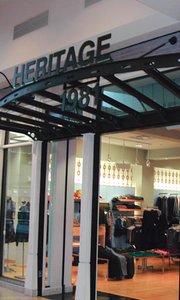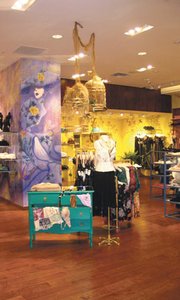Forever 21 Goes Global and Looks for Bigger Stores
With an eye toward becoming a publicly traded company, Forever 21 Inc. is expanding to South Korea and China as well as pumping up the size of its retail outlets to resemble fashion department stores.
The Los Angeles chain of fast-fashion clothing has aggressive plans to build a 2 million-square-foot shopping mall in Seoul, the capital of South Korea, as well as four other shopping malls there. In addition, it will open five Forever 21 stores in the suburbs ringing Shanghai.
If that weren’t enough, the company’s new retail strategy is to open larger stores that are at least 30,000 square feet or more in an effort to pump up its same-store sales and carry more merchandise.
Plans are to add 1 million square feet of retail space to the mix this year after doing the same last year. That will help boost the company’s revenues, which totaled $1.3 billion in 2007, to at least $1.5 billion in 2008. Eighty stores will be added to the current 401 in the chain.
The bigger-store concept comes more than a year after Forever 21 opened its first 40,000-square-foot emporium in the old Saks Fifth Avenue space in Pasadena, Calif., in mid-2006. The elegantly styled store, with marble-tiled floors, chandeliers and a curving stairway to the second floor, still carried inexpensive merchandise, but it was a departure from Forever 21’s previous malloriented stores frequented by the 15- to 25-year-old typical customer. But the Pasadena store has been a success, generating more than $15 million in sales last year, the company said.
“We have felt there was not enough oxygen in our stores with the merchandise we have,” said Christopher Lee, a senior vice president with Forever 21. “As we increase square footage, we actually increase our sales per square feet. It goes against the common retail concept. hellip; In order to have good [same-store sales] throughout the year, we need to have space. ”
This is a gigantic departure from 1984, when company founder Don Chang opened his first modest 900-square-foot store in Los Angeles’ Highland Park neighborhood. The store is still there on Figueroa Street.
But getting bigger and better has been Chang’s dream. With that in mind, Forever 21 has been on an aggressive search for roomy spaces instead of the typical 10,000-squarefoot mall store. It recently signed a deal to take over the 40,000-square-foot space left vacant last summer by a Virgin Megastore that closed on Michigan Avenue in Chicago. That store, with menswear, childrenswear, cosmetics and lingerie, will open before the Back-to-School season.
Forever 21 also has signed a lease to open a 35,000-square-foot outlet in the Westfield Fox Hills mall in Culver City, Calif., that will open in the summer of 2009, again with a selection of menswear, childrenswear, lingerie, more accessories and an extensive selection of clothing.
Other retail openings include:bull; a 30,000-square-foot store in the Aventura Mall near Miami, which will open this summerbull; a 32,000-square-foot store opening in November 2009 at The Mall at Short Hills in Short Hills, N.J.bull; and a 55,000-square-foot space in the retail portion of the mixed-use project called Meadowlands Xanadu in East Rutherford, N.J., that still doesn’t have an opening date.
When its current projects are done, Forever 21 will have 30 department-size stores in its lineup.
Some wonder if Forever 21’s aggressive growth plan might be in response to H & M, the Swedish fast-fashion retailer that has been briskly opening doors throughout the United States. Its first U.S. store appeared in New York City in 2000, with a slew of doors to follow. The first California outlet opened in Pasadena in 2006.
But retail analyst Jeffrey Klinefelter of Piper Jaffray believes there are other motives behind the rollout. “I think larger stores and developing a next-generation department store has been part of the long-term strategic vision of Mr. Chang and the Forever 21 organization for several years,” he said. “While they have capitalized on the broad category of the fast-fashion segment of the retail industry, I don’t think they are limiting themselves to one store brand or one prototype or one global region as they look at international locations, owned or franchised, where they see opportunities and inefficiencies in the marketplace.”
With new store concepts in mind, Forever 21 in 2006 purchased 44 Rampage mall stores from San Diego–based Charlotte Russe Inc. for $14 million. Those spaces are being used to test-market new retail concepts and labels. The first concept out the door was Heritage 1981, which debuted in late 2006. The store, with more of a homey, down-to-earth vibe than the light, bright Forever 21 stores, stocks trendy, edgy clothes for the hipper Forever 21 client, who tends to be between 20 and 30 years old.
And this May, Forever 21 plans to depart from its tried-and-true supply of inexpensive clothing, selling for $20 to $50, and go more upscale with a new store called Twelve by Twelve. It will open in the Beverly Center, located near Beverly Hills. The young contemporary line of sophisticated apparel, with price points between $24 and $100, is the brainchild of Betsy Zanjani. The label is already available in some Forever 21 stores, but this is the label’s first dedicated outlet.
While diversifying your product mix is considered a good business strategy, it can also drift into dangerous territory. “They better be careful,” said Britt Beemer, founder and chairman of America’s Research Group in Charleston, S.C., which conducts consumer surveys and tracks retail trends. “When you expand out of your core category, you become meaningful to nobody.”
Going public
But expansion will always be part of the game plan at Forever 21, particularly outside the United States. Don Chang and his executive staff are making a big push to develop American-style shopping malls in Chang’s native South Korea.
Already, the company is lining up 2 million square feet of land to lease for a shopping-mall project expected to open in 2010 or 2011. Forever 21 is looking for big-box stores, hotels and restaurants to anchor the mall and is even willing to sign franchise agreements with major retailers to set up their stores. “We are willing to risk our own nickel,” Lee said.
Forever 21 believes these shopping centers will be instant moneymakers. “Many retailers are focused on China, India and Japan, and people seem to have overlooked Korea,” Lee said. “We want to take iconic brands and grow them there.”
Forever 21 has four other shopping malls in South Korea on the drawing board, taking advantage of a mass privatization program of land and companies going on in South Korea. President-elect Lee Myung-bak has announced plans to privatize the Korea Land Corp., the Korea National Housing Corp. and the Korea Housing Finance Corp. At the same time, the U.S. military is downsizing its presence in South Korea, turning over 66 bases to the government by 2011.
One of the reasons Forever 21 is growing so aggressively is that the company has a vision of becoming a publicly traded company, Lee said. Recently, Forever 21 gave a glimpse of its future plans at an investment conference in Dana Point, Calif.
“We are getting ready to go public,” Lee admitted. “When exactly, I don’t know. When the time is right.”
























